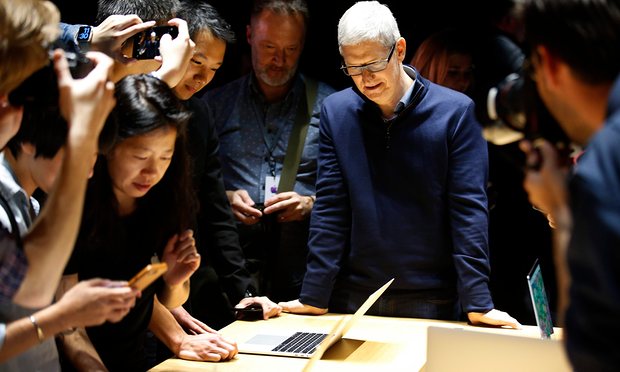After a long period as a mid-market manufacturer, rapid shift signals a reaction to the changing shape of the PC market
Apple released its latest laptops on Thursday, a new range of computers to replace the ageing range of Retina MacBook Pros. They are thinner and lighter than their predecessors, with a new touch bar at the top of the keyboard and a fingerprint sensor replacing the power button.
They are £750 more than the machines they replace were – though their price has also gone up. The larger of the two new MacBook Pros, the 15in with Touch Bar, is the first laptop the company has released with a starting price of more than £2,000 for more than a decade: it begins at an eye-watering £2,349, with build-to-order options taking it well north of £4,000.
Apple’s former cheapest laptop, the £749 MacBook, is also being retired. With the next cheapest going up in price due to post-Brexit currency swings, there is now only one Apple laptop available for less than £1,000: the £949 13in MacBook Pro, an almost two-year-old computer that is likely to never see another update.
Brexit hits Apple Mac customers hard as prices rise by up to £500
Read more
It too has been quietly replaced by another top-end machine, 2015’s MacBook: a £1,249 ultralightweight laptop with one port, one headphone jack, a mobile processor and a width of just 13mm.
After a long period as a mid-market manufacturer of some of the most popular laptops on the market, then, Apple is back to making premium computers for the very top end of the market.
“Apple has always had a firm strategy on the high-end of the market with adding a few models towards the mid-range to attract new user groups,” says the Gartner analyst Annette Zimmermann. She argues that the new models’ touch bar is the perfect feature to reposition the overall range towards the high end, as well as taking on competition from other computer manufacturers that have been building their own touchscreen devices.
Advertisement
The shift has been rapid, and reflects the changing shape of the PC market, Apple’s attempts to refashion its line-up of computers and mobile devices for that altered world, and some new competition from an old foe, says Ben Wood from the analysts CCS Insight.
“We shouldn’t forget that the last significant update to the MacBook Pro family was 2012,” he says. “I think it’s a real indication of the broader malaise in the notebook market that Apple was able to get away with selling a four-year-old product as successfully as it has. All they had to compete with was some nasty black plastic from Dell or HP.”
But over those four years, the PC market has shrunk consistently. In 2015, 164.4m units were sold, according to TrendForce, while that is expected to fall to 157.4m this year. The cause is obvious: the rise of mobile and tablet computers have allowed users to do more with less, be that replacing a laptop with an iPad, or simply never buying a full computer in the first place and going online with a smartphone.
Different companies have responded in different ways: first, by focusing less on their computer divisions as they chased the market to mobile, but later, by recognising that the smaller size of PC industry allows for greater segmentation of the market. One of the first to really push that to its limits was Apple’s old foe Microsoft.
Since 2012, Microsoft has been building its own line of hardware, based on its Surface range of tablets. Where the initial devices were intended to act as iPad competitors, in recent years the company has positioned the latest Surface devices as hybrid tablet/laptops capable of doing the work of either.
This month, it stepped up the competition even further, introducing the Surface Studio, a $3,000 (£2,460) desktop machine intended to provide the perfect working environment for the likes of visual artists who can make the most of its 28in touchscreen.
“We could be entering a new arms race in these premium computing devices,” says Wood, “with Microsoft stepping up and giving Apple a run for its money. Apple is currently saying that they see a clear distinction between touch-based products, like the iPad and iPhone, and Macs, where they are going to great lengths to avoid putting touchscreens on the main device. Microsoft has a different strategy.”
Apple’s motivation to redefine its laptops may also have been driven by a desire to more fully distinguish between its iPads and its MacBook range. Until last week, the most expensive iPad, the 12.9-inch iPad Pro with Wi-Fi and mobile data, was more expensive than Apple’s cheapest laptop. That posed a problem for Apple, which struggled to explain what the two devices were for: if a laptop is best for work on the move, who would pay more for an iPad?
Now, it can more consistently structure its messaging: iPads are cheaper, hardier portable devices with all-day battery life, but if your main computer is to be portable, a premium laptop is the way to go.
The downside for British customers is that Apple has picked perhaps the worst possible time to enact the change. Thanks to the collapse in the value of the pound, the company repriced its entire line – even older, unchanged computers – raising the price of some by as much as £500 to account for the new exchange rate. That means customers who were holding off until new computers came out have suddenly found that the older computers are more expensive as well.
Apple said: “Apple suggests product prices internationally on the basis of several factors, including currency exchange rates, local import laws, business practices, taxes, and the cost of doing business. These factors vary from region to region and over time, such that international prices are not always comparable to US suggested retail prices.”
Do you prefeer laptops or tablets? What do you mean?
(theguardian.com)
Fuente: www.theguardian.com
